The Bank of England has announced that Enigma cryptanalyst Alan Turing will appear on the new £50 banknote.
As far as I know, it will be the first time in history that a notable cryptologist is depicted on a banknote. Mathematician Alan Turing (1912–1954), who plaid a crucial role in breaking the German cipher machine, Enigma, during WW2 and constructed the voice encryption machine Delilah, will be the face on the new British £50 note (thanks to Tobias Schrödel for the hint). This was announced today by Bank of England Governor, Mark Carney, at the Science and Industry Museum in Manchester.
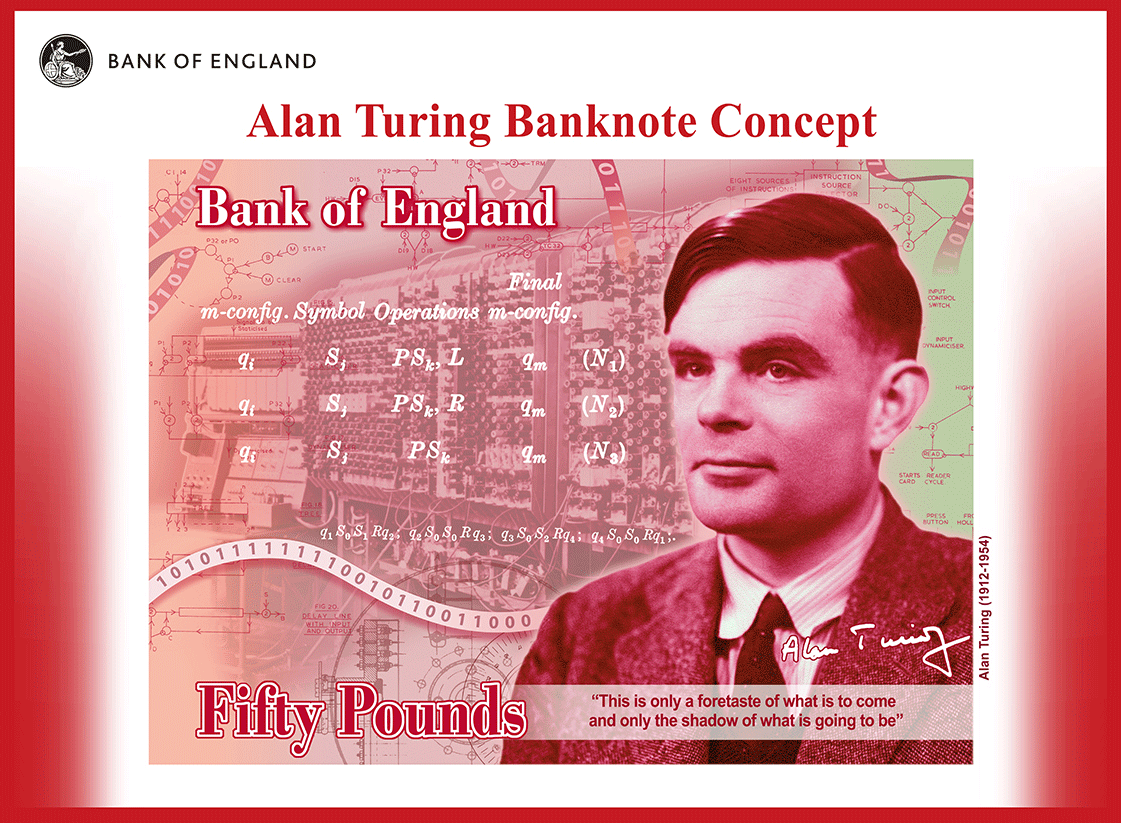
The Government and Company of the Bank of England 2019
Carney also revealed the imagery depicting Alan Turing and his work that will be used for the reverse of the banknote. The new means of payment is expected to enter circulation by the end of 2021.
Turing: an outstanding mathematician
According to a Bank of England press release, Alan Turing was chosen following a selection process including advice from scientific experts. In the first step, the Banknote Character Advisory Committee chose to celebrate the field of science on the new £50 note and this was followed by a six week public nomination period. The Bank received a total of 227,299 nominations, covering 989 eligible persons. The Committee subsequently decided on a shortlist of 12 options (including Paul Dirac, William Herschel, Ada Lovelace, Charles Babbage, and Stephen Hawking), which were put to the Governor for him to make the final decision.
The press release quotes Mark Carney as follows: “Alan Turing was an outstanding mathematician whose work has had an enormous impact on how we live today. As the father of computer science and artificial intelligence, as well as war hero, Alan Turing’s contributions were far ranging and path breaking. Turing is a giant on whose shoulders so many now stand.”
Not only in the crypto community is Turing best known for his codebreaking work in Bletchley Park during WWII. Together with Gordon Welchman, he constructed an Enigma breaking device today known as “Turing Bombe” or “Turing-Welchman Bombe”.

Source: Schmeh
When constructing the Bombe, Turing benefitted from work performed by Polish mathematicians in the 1930s. The name of the device was derived from a Polish Enigma breaking machine named “Bomba”. However, the design concepts of the two devices are completely different. While the Bomba requires that the encrypted session key is sent along with a cipher message, the Turing-Welchman Bombe needs a plaintext part, i.e., a crib in order to break a ciphertext. This crib can be configured using plugs and wires on the rear-side of the machine, as shownon in the following picture from the movie The Immitation Game (with Benedict Cumberbatch as Alan Turing):
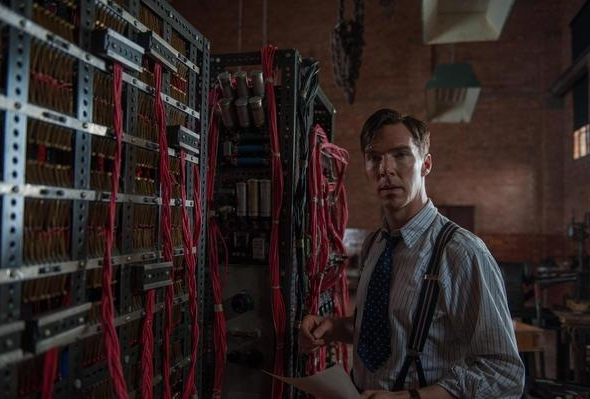
SquareOne Entertainment, used with permission
Later in the war, Alan Turing co-developed a notable voice encryption device named “Delilah” together with Donald Bayley.
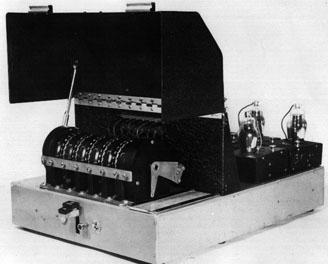
Source: Bletchley Park
Voice encryption proved a serious challenge to the engineers of the Second World War. There were many tries to construct a usable system but most of them never made it to practice. The ones that did were either extremely complicated (such as the SIGSALY) or insecure.
Although Turing had very limited resources when he constructed this machine, the Dililah is certainly one of the best voice encryption designs of its time. However, it was completed too late to be used during the war.
Turing: a computer pioneer
In addition to his crypto work, Alan Turing provided the theoretical underpinnings for the modern computer. He set the foundations for work on artificial intelligence by considering the question of whether machines could think.
As is well known today, Turing was homosexual and was posthumously pardoned by the Queen having been convicted of gross indecency for his relationship with a man. His legacy continues to have an impact on both science and society today.
Alan Turing didn’t have children – contrary to his brother John, whose son Dermot Turing was born in 1961. Dermot is very active in writing and giving lectures about his famous uncle. I met him several times at crypto history conferences. His latest book is X, Y & Z: The Real Story of How Enigma Was Broken.
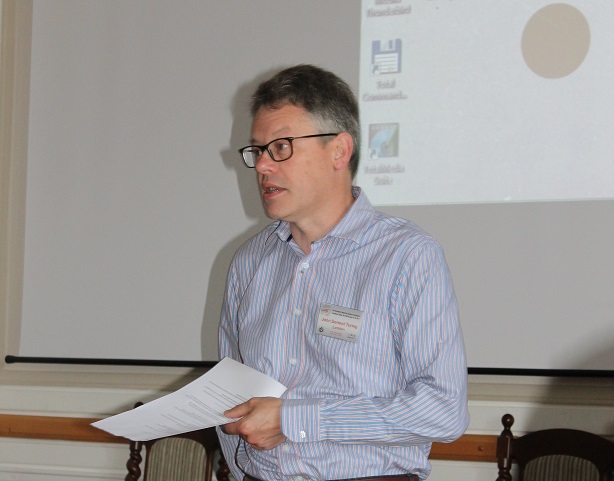
Source: Schmeh
The design of the banknote
As can be seen in the image above, the design of the banknote will feature:
- A photo of Turing taken in 1951
- A table and mathematical formulae from Turing’s seminal paper On Computable Numbers, with an application to the Entscheidungsproblem
- The Automatic Computing Engine (ACE) Pilot Machine
- Technical drawings for the Turing Bombe
- A Turing quote: “This is only a foretaste of what is to come, and only the shadow of what is going to be.”
- Turing’s signature
- Ticker tape with a message in binary code. Can a reader decode it?

- The concept of a machine fed by binary tape
In my view, it’s a great decision to depict Alan Turing on a banknote. I’m sure, everybody interested in crypto history will agree.
Follow @KlausSchmeh
Further reading: A Turing Bombe simulator and an unsolved Enigma challenge
Linkedin: https://www.linkedin.com/groups/13501820
Facebook: https://www.facebook.com/groups/763282653806483/

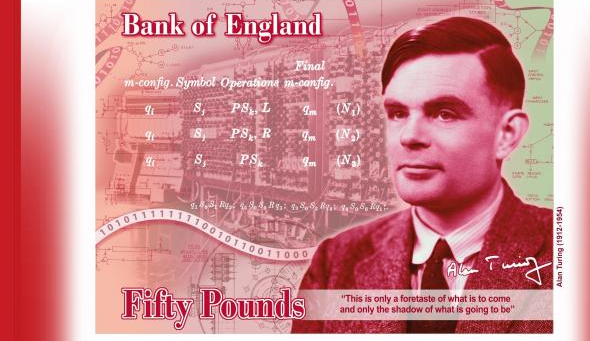

Kommentare (4)